The 6.5L GM diesel engine was introduced in 1992 to replace the 6.2L diesel engine and was in turn replaced by GM’s Duramax 6600 in 2001. On the surface it would appear that the story of the 6.5L diesel would end here, right? Well, that wouldn’t make much of an article.
In actuality, production of the 6.5L diesel engine ended for GM in 1999 and a new chapter of its production began shortly thereafter with General Engine Products (GEP), a wholly owned subsidiary of AM General. GEP built a new facility in Franklin, OH specific to the 6.5L diesel engine, using the latest innovations and technologies of manufacturing available.
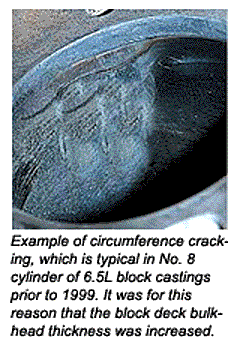
AM General entered into an agreement with GM to provide the exclusive ownership of the Hummer brand name which subsequently was renamed the Hummer H1. AM General continued to manufacture and assemble the H1 for GM through 2006, and in 2002 began assembling the H2 for GM.
Today, AM General continues to build the latest developed rendition of the 6.5L for many military application vehicles, the most popular of which is the High Mobility Multi-Purpose Wheeled Vehicle (HMMWV, better known as the HUMVEE). The Optimizer 6500 diesel engine now produces 205 hp and 440 ft.lbs. of torque and there have been numerous improvements made to ensure its long term reliability. It’s definitely NOT the same old GM 6.5L.
Before we get into any of the proliferation reports, let’s talk about some of the issues that have given the older 6.5L its black eye reputation. While a number of these things have been rectified, some of the aftermarket solutions may or may not be an advantage.
Take note that these issues are distinct to the 6.5L GM engine and not the AM General 6500 Optimizer engine. To think they are the same would be like comparing apples to oranges – you just can’t do it.
The brightest spot in all of this is that a 6500 Optimizer will retro back for every 6.5L engine application with little or no modifications. GEP actually provides “de-tuned” applications that will even retro into naturally aspirated applications back thru 1992.
Cylinder Blocks
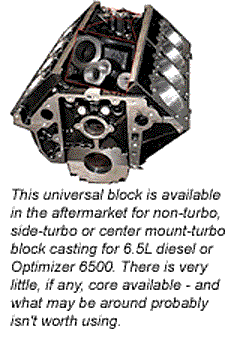
One improvement made has been to the block fire deck – it’s been made thicker and more robust. The 1994 through 1998 turbocharged engine blocks were prone to circumference cracking, particularly in the Number 8 cylinder (see photo at right, and GM Service Information Bulletin 98-02-05 dated 09/98).
Although there are a number of reasons for the cracking issue, all of them contribute to “the REAL problem:” the back two cylinders of the engine run hot. Coolant flow in the rear of this engine is an inherent issue. You can easily find kits on the Web to install braided lines and fittings that claim to equalize the flow in the rear of the engine between the cylinder heads, touting their capabilities with great success. I leave the end results to your own evaluation.
Another reason for the high rear cylinder temperatures is because the exhaust manifolds are tight against the rear of the engine. Especially with the center-mount turbo, the rear of the engine runs hot. In fact, the piston to wall clearance for the rear two cylinders is .0005″ more than the other six in the OE specification. In the aftermarket some manufacturers even recommend additional .001″ clearance. Mahle has come out with a coated piston for this application, which greatly reduces the possibility of scuffing even in the worst of situations and can be particularly beneficial in the marine application.
There is another cracking situation that can occur in the cylinders, although less frequently. When piston cooling jets were introduced, the main bearing saddle in the block needed to be drilled to insert the continuous flow orifice-controlled piston oilers.
Apparently the tooling would at times clip the bottom of the cylinder and, of course, would create a stress riser in the bottom of the bore. Occasionally, that would begin a vertical crack in the cylinder wall, most commonly in blocks that had a slight casting shift during their casting process. These were blocks that ended up with a thinner wall thickness, coincidently, right in that area where the tooling clipped the cylinder.
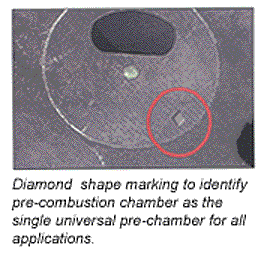
Another issue has been with the main bearing caps, bolts and bulk head webbing. Let’s start with what has happened with the Optimizer: the bulkhead is now .020″ thicker, the main caps are taller and the casting is now manufactured with Molybdenum in the iron. Additionally, the outer main bearing bolts are 10mm vs. the former 12mm. This has, for all practical purposes, eliminated the main bearing problems.
However, the aftermarket is a whole other world. Engine rebuilders have been very innovative in an attempt to find a work-around solution to the main webbing cracking and bearing failures of the earlier casting.
One idea has been to eliminate the main bearing bolts and go to studs as a solution. They have added thread repair inserts to the outer main bearing bolt holes that were prone to cracking with the 12mm bolts. They have drilled small holes at the end of the cracks so that they will not travel. They have gone to the use of splayed main caps. There are even aftermarket main girdles available.
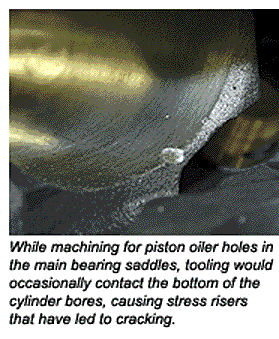
Personally, I’m not certain that any of these solutions are viable for the pre-1999 blocks. In fact in the PER world those early blocks are considered scrap. To put it bluntly, the main web bulkhead was deficient in design and there is no way to make that better, other than to replace the block. All of the attempted solutions mentioned above have had very high failure rates, and are band-aids at best.
That said, it sounds like an easy but somewhat costly solution, to just buy a new block, right? Sorry, the bad news is that you cannot buy a new block from GEP. Still, there is light at the end of that tunnel and it’s not a train bearing down on you. There are a number of different aftermarket 6.5L diesel engine block, cylinder head, crankshaft and connecting rod manufacturers today. In fact, I found a manufacturer that provides a universal block for non-turbo, side turbo, and center turbo applications. We’ll talk more of these potentials later in this article.
Cylinder Heads
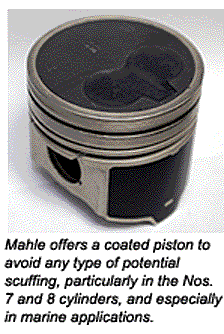
Like the attempts at solutions to the 6.5L block issues, there are whole other arrays of innovative initiatives to talk about with cylinder heads. Let’s start with the one that seems to have gotten by almost the entire engine builder sector. NEVER resurface this cylinder head with the pre-combustion chambers in place. They MUST be removed. They will move, they will shift, they will suck into the grinding wheel and appear to be level with the surface and then drop into the cylinder head upon installation and cause a cylinder head gasket leak. The good news here is that the pre-combustion chambers can be easily removed if you insert a narrow nylon or brass drift through the injector nozzle hole and then simply drive them out. Pre-chambers should have 0″ to .001″ interference fit and be flush to .002″ above the deck for proper sealing with the head gasket that goes across the top of the chamber. Word on the street is you can even get away with .003″ above the deck, which is certainly preferred over flush.
Pre-combustion chambers are also available from GM in .010″ oversize OD. So how do you get the chambers at the correct height after resurfacing the cylinder head, or machine the pocket for .010″ oversize? You could certainly set up the head on a Bridgeport type mill and machine the pockets, but that is typically not economically feasible. Your other option is tooling such as the one provided by Rottler Manufacturing that will do the process quickly and accurately.
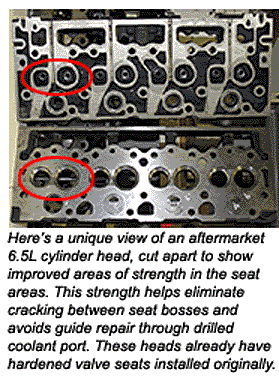
There were a large number of proliferations of the pre-chambers and they have been narrowed down to four GM part numbers and identifiers: p/n 10149630 with a T stamped on the surface, VIN F, 1992-1993; p/n 10230426 with a square stamped on the surface, VIN Y, 1994-Up naturally aspirated; p/n 10149629 with a circle stamped on the surface, VIN S, 1994-Up; and p/n 10183926 with a diamond stamped on the face, VIN F, 1997-Up.
Oddly enough, everyone that I have spoken with in the PER sector concerning remanufacturing this engine, has gone to the diamond pre-chamber (see photo on page 54) for all applications and has seen absolutely no detrimental effects, runnability problems or emissions issues.
One last thing about pre-chambers: both GM and industry association bulletins indicate that cracks up to 3/16″ long are acceptable for reuse. I leave you with this: would you put a 3/16″ long cracked component into your own engine? Put a new set of diamond chambers in and feel good about doing the right thing.
The original cylinder head casting has induction hardened valve seat areas of the cylinder head casting without inserts, and when either cracked or worn beyond machining limits normally requires valve seat inserts to be installed. These heads have been extremely vulnerable in this area and often times when installing inserts you will get into the water jacket. Again, there are a number of aftermarket new castings that are available to resolve this situation later in the article.
The original head was also prone to cracking between the intake and exhaust valve seat area, and again, many engine builders have been using a valve guide liner for this engine. Four drilled cooling passages between the intake and exhaust seat area are
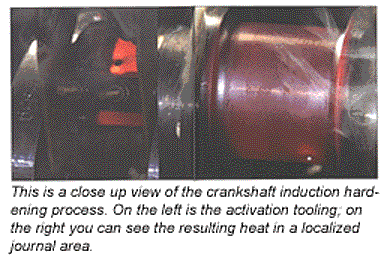
accessible through four soft plugs on the intake side of the cylinder head. You’ve probably seen industry association bulletins about this repair, but once again this is a band-aid for an inherent casting problem that has ultimately resolved nothing but temporarily circumvented the inevitable. The cylinder head is still cracked in a vulnerable area and all that has been accomplished is the little Dutch Boy has stuck his finger in the dike. That it will leak again is a certainty.
Pushrods for this engine are specific in their orientation in the engine. They have a very specific difference in their hardness from end-to-end. The side with a paint stripe or copper coloring must go to the rocker arm side or the top of the engine. Failure to install the push rods correctly will result in premature engine failure without question. Valve recession for both the intake and exhaust valves is .034″ – .048″ – being outside of these specs will result in hard starting, white smoking and/or runnability issues.
Other than the pre-combustion chambers the heads for the various engine configurations are basically the same except for the angle of the intake manifold bolts. The naturally aspirated or side-mount turbo applications have bolts that are at 90 degrees to the intake manifold surface. Intake bolts that are at 60 degrees (photo below) to the intake manifold mounting face are found on the center-mount turbo manifold.
Regardless of their angle, the head bolts use a torque-turn method for clamping the head to the block. And for those of you who are metallurgists, the head bolts have a maximum yield point of .023″ and optimum at torque is .017″-.019″ yield.
Crankshafts And Connecting Rods
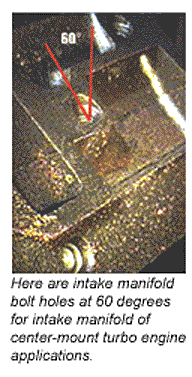
There is not a lot to talk about here. The crankshaft is induction hardened cast iron with rolled fillets and a one-piece seal rear flange. The flywheel bolts require sealant or they will leak. If torqued over 65 ft.lbs., as described by the OE spec, a rear seal leak will occur due to distortion of the rear seal area.
The connecting rods are forged with a full floating wrist pin bushing. In the reman process it is certainly advisable to bore them to the center-to-center length of 6.280″.
Entrepreneurial Innovation
It is not often that you run across an engine that has had as much innovation of redesign and improvement to the original design come out of the aftermarket sector as the 6.5L diesel. I am not certain that it says as much about the original design as it does about the entrepreneurial spirit that truly remains in this industry. There was a need that could not be filled by the original resource so there were those that rose to the occasion and filled the need.
By that I mean you can purchase in the aftermarket a 6.5L cylinder block, cylinder head, crankshaft and connecting rods as brand new castings and forgings and actually compete in the reman sector and tout a strong competition to the brand new long block.
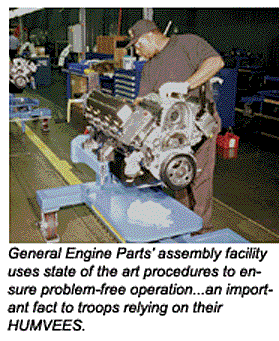
During my research for this article, I looked at a number of different components and have to admit that the one company that stood out was Diesel Head & Parts (www.dieseldhp.com).
Not only were they helpful in much of the information gathering and the networking to make it possible but I was amazed at the innovation they have accomplished (shown in the aftermarket heads and blocks referenced in this article) not only in the 6.5L diesel engine but many others such as Cummins, Caterpillar and International.
Thanks also to the folks at General Engine Parts for the spectacular tour of their manufacturing facility and the information on the Optimizer 6500.













